Everyone visiting The National Archives has a responsibility to preserve the documents in our care.
We do not allow gloves to be worn in our reading rooms, in line with long-standing guidance relating to the preservation of our collection. All visitors to the reading rooms are asked to wash their hands before and after their visit.
There are some general practices that should be followed by everyone:
- wash your hands before you start working and avoid using hand cream and hand sanitiser in the reading rooms
- do not lick your fingers when turning pages
- avoid leaning on or touching the document, use a paper marker to follow the text
- use powder-free nitrile gloves when handling photographs, and hold them by the edges (the only exception to our gloves rule – the natural oils in skin can damage the surface of photographs)
Please keep the documents in the order in which you received them.
Do not:
- remove individual items from files, volumes or boxes
- de-tag any file
- attempt to re-file the items in your preferred order
While working with documents:
- ensure you are not holding them while reading and make sure they do not hang off the edge of your desk while reading
- use the preservation aids provided to ensure that documents are fully supported
- turn pages with care
- do not put items on top of them
Preservation aids are available at clearly marked locations throughout the reading rooms. If you are having problems with a particular document – for example, if it is very heavy or too fragile –please contact a member of staff.
Find out more about preservation at The National Archives.
Handling files
Files consist of loose sheets held together in one corner by a treasury tag. The type of paper and the page size may vary, and files may contain photographs, or folded maps and drawings.
Check the tag length
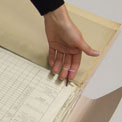 The tag should be long enough so that you can turn the pages when the file is fully open. If the tag is not long enough, please take the document to a member of staff who will retag it for you.
The tag should be long enough so that you can turn the pages when the file is fully open. If the tag is not long enough, please take the document to a member of staff who will retag it for you.
Turn the pages carefully
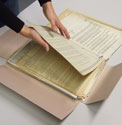 The punched hole is particularly vulnerable and easily torn.
The punched hole is particularly vulnerable and easily torn.
Please ask for assistance if the file is damaged or badly tagged.
When you have finished
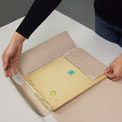 Tuck the pages inside the cover so that they are protected.
Tuck the pages inside the cover so that they are protected.
Handling parchment
Many of the early records, including treaties, charters and wills, are made of parchment. These may be bound volumes, documents with wax seals, or large rolls made from several sheets of parchment sewn end-to-end.
Parchment is made from animal skin so does not absorb ink like paper does. This means that the text is particularly vulnerable to inappropriate handling.
Avoid touching the document
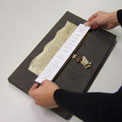 Use weights to hold the parchment in place. Use a paper marker to follow the text instead of fingers.
Use weights to hold the parchment in place. Use a paper marker to follow the text instead of fingers.
Pendant wax seals
 If a pendant wax seal is attached to the document, ensure that the seal is resting on a foam pad. When turning the document over, be sure to turn the seal at the same time.
If a pendant wax seal is attached to the document, ensure that the seal is resting on a foam pad. When turning the document over, be sure to turn the seal at the same time.
Parchment rolls
 When scrolling through the document, re-roll it as it is read. Use weights to hold the roll in place.
When scrolling through the document, re-roll it as it is read. Use weights to hold the roll in place.
Handling books
Many different styles of binding are to be found at The National Archives, from limp vellum bindings, to library bindings and account bindings.
Ask staff for help if a book is particularly large or heavy, or if pages are stuck together.
Provide support
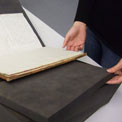 Use wedges to support the book at an angle. This puts less strain on the spine and creates a comfortable reading angle. Use a foam pad for additional support at the beginning and end of the book.
Use wedges to support the book at an angle. This puts less strain on the spine and creates a comfortable reading angle. Use a foam pad for additional support at the beginning and end of the book.
Avoid touching the document
 Use weights to hold down pages, and use a paper marker to follow the text.
Use weights to hold down pages, and use a paper marker to follow the text.
Handling maps and plans
There are many different types of large-scale document, including maps, plans, blueprints and posters. These may be stored flat, rolled or folded.
Make space
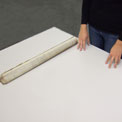 Make sure that you have enough space before unrolling a large document.
Make sure that you have enough space before unrolling a large document.
Avoid touching the document
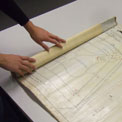 Use weights to hold down pages, but place them round the edge, rather than on top of the printed or drawn image.
Use weights to hold down pages, but place them round the edge, rather than on top of the printed or drawn image.